-
Drip

Lines layed out up the property The key to any garden is the availability of water. Today I signed a contract to have a well drilled on my property to furnish irrigation and pond water. The irrigation for the permaculture project, and for most of my other gardens, will be subterranean drip. Yep, this is expensive. However, it will pay off in long-term water bills, plant loss due to drought or the heavy salt that is found in our water (the well should pull from beneath the salt penetration), and the replacement of sprinkler heads, broken PVC pipe and connectors for which my dogs and tortoise seem to aim.

Drip lines uncoiling As the plant guilds mature and roots and loam deepen, the less water I’ll need to provide for the gardens. The system will be there for the drought months, and for future unknown circumstances.

Where future plants will be I have the luxury of having a little inheiritance to spend on having others install this garden for me. That is because I do not have the luxury of having available labor in the form of willing, available and capable family members, nor do I have the physical strength in my back or hands that I once had to do it all myself. And I want it done NOW, so that I can play with it, enjoy it, plant and replant it, watch the habitat fill with animals, and show others what a success permaculture can be so they can practice it themselves.

Irrigating the beans and vines My real thrill is in my veggie garden. As I’ve mentioned before, I’ve had a garden most of the twelve years I’ve lived here, and have been foiled by bermuda grass and gophers. I finally was able to nail together boards from an old bookshelf to make raised beds, then buy on sale some pre-made raised beds. I’ve stapled aviary wire into the bottom, leveled them, filled them with a mixture of dirt, compost and whatever else that could fill those babies up. I’ve used natural fertilizers and microbes this year to energize the soil, and ran PVC pipe to each bed with a riser and a split hose bib on each one.

Double hose bibs Finally today I finished the drip system in each bed. (Yey! Hurray! Whoopee!). I’ve used drip irrigation before in the beds, with the long black soaker hoses perforated all over so that they ooze water. They say that they can be buried, but the mud cakes onto the tubing and gums it up. Also, to connect pieces you have to ram ends onto the cut ends which I have found really hard to do. Then you have one configuration of the hose with not many options for change. Ick!

Old soaker hoses I found another kind of drip hose (at WalMart) which is 75 feet of thin plastic tubing sheathed in a permiable nylon casing.

Plastic tube inside a nylon sheath The hose is fitted with a male and a female hose end, and the whole thing rolls up. Perfect!

Flexible drip hose! What I wanted was to be able to lay out drip from each hose bib on each bed that could be rolled up without a fuss when I’m working on the bed. I also wanted individual controls in the beds so that I’m not watering a bed that isn’t planted, or I can water half a bed and not the other half, or allow more water for crops such as melons and little water to crops such as quinoa… all at the same time! Complete control! Ease of use! Water savings! Ha!
Instead of using both sides of the divided hose bib for each bed, at this time, I ran one line in each bed. I can and probably will change that later which won’t be a problem, but I wanted to get these babies going! Since my beds don’t need 75 feet of hose, I lay down the amount needed then cut the end, tying a knot in it to stop the flow of water.

Tying off the end On the next section of hose I attached a female hose end, and moved onto the next bed.

Attaching female hose ends It worked! I had to adjust two of the hose bibs that leaked, but with my trusty Phillips screwdriver all went well. I have two more raised bed frames that I bought to install, and I have hose enough for both of them left over. I still have a sprained wrist (I’m really trying not to use it much, and wear a brace, but there is just so much to do!) so digging and leveling the ground for the beds is probably not a good thing for me to do right now, and I sure have a lot of weeding to do in the front yard (left handedly!), so the beds might wait.

Quinoa doesn't want much water So I’ve conquered the gophers, and I’ve conquered the hand-watering and bad drip hose, but I am seeing bits of that darn Bermuda grass coming up in some of the beds. I swear that that stuff could come up through anything. I’ve seen it break apart asphalt, and also come out the top of a six-foot pipe. Horrible, nasty stuff. Fortunately the soil is so much better in my beds now, it is easier to root around and pull the stuff out from way down low.
Anyway, that’s my drippy story for the day. I’m immensely happy about my veggie garden, and slightly less panicky about the dry days cooking all the new plants in the permaculture garden if I’m not out there dragging hoses around with my bum wrist watering for several days. And I didn’t talk about peas once. Oops!
-
Plantain Chips, or Tostones

Bananas versus Plantains A couple of years ago my daughter and I enjoyed a five-day birding tour of the high country in Ecuador, then an eight-day tour of the Galapagos islands. Being vegetarian wasn’t a challenge there; we ate very well and enjoyed foods that we hadn’t encountered before. One of the foods that was in many meals was plantain. Plantain around here means the lawn and stream-side weed that helps treat stinging nettle and insect bites. However plantain the fruit look like bananas, but are prepared very differently. High in iron, potassium and fiber, they are very versitile and often used in recipes instead of potatoes.
Plantains can be used in three stages of ripeness. When they are green they are starchy and hard to the touch. They are often boiled and mashed like potatoes. When they are yellow, they are sweeter as the starch has converted to sugar, but still not soft and are difficult to peel. When they are black, but not mushy, they are sweetest.
A common snack in South America and also in Africa are plantain chips. In Ecuador they are called tostones and sold in bags like potato chips. They are very easy to make, and very yummy to eat. Photos follow the recipe.
Plantain Chips, or TostonesAuthor: Diane KennedyRecipe type: SnackPrep time:Cook time:Total time:Serves: 2-3Fruit snack chip found in South America and Africa.Ingredients- Three plantains, yellow or slightly black
- Oil for frying
- Salt.
Instructions- Boil a small pot of water and submerge the whole unpeeled plantains for several minutes. The skins may begin to crack.
- Remove from boiling water and allow to cool.
- Peel the plantains and slice into ¾ inch disks.
- Heat enough oil on medium-high heat in a large skillet to cover the bottom.
- Lay sliced plantains in the oil and fry for about three minutes. They will be soft. Remove from oil and place on a plate lined with paper towels.
- Keep the oil temperature the same.
- Using the bottom of a glass, flatten the softened plantains so that they are very thin. Sliding a metal spatula under each chip when smashing helps. (A Puerto Rican version has you dip the disks into cold water just before refrying, to make them crisper. It would also make the oil splashier.)
- Lay the flattened disks back into the oil and fry for another three minutes or so.
- Remove the now crisp disks to a paper towel for draining.
- They will crisp even more as they cool slightly.
- Eat as is, or lightly salt, or sprinkle with chili-lime powder.
- They are very good with dip, too.
- Makes about thirty chips.

Scald whole plantains to make peeling easy 
Peel cooled plantains 
Using a spatula under the plantain slice helps when squashing with a glass 
Fry slices a second time .

Nom! -
Taking the “Ew!” out of Tofu

Working Tofu Magic I’ve been an ethical vegetarian for seventeen years, raising both my children without animal protein as well. Believe you me, packaged vegetarian foods have come a looonng way in palatability. There is a whole new world of packaging rife with misspellings and quotation marks, such as “chickn” and “bakon”, just to make sure that no hen or pig will sue the company for false representation. Many vegetarian options were simply god-awful to eat; some still are. It is still hard to find products that aren’t filled with pieces of red and green peppers (ick!), whose flavor permeate the rest of the food making it disgusting if it had been palatable at all in the beginning.
There are wonderful meat substitutes that can vary a menu and add protein, and the ability to create mock meat has become an art and can be found in many restaurants, especially Thai or Chinese. I order several times a year from May Wah in New York, who sells mock meats created in Taiwan. Morningstar Farms makes wonderful standards such as fake bacon, sausage links and patties, chicken strips and meatless crumbles (like ground beef).

A host of good pseudo-meat products When my daughter and I toured England four years ago, the popular vegetarian option on all the menus that year was mushroom risotto. We ate quite a lot of mushroom risotto, as well as some very strange stuffed onions which were stuffed… with more onions.
Although there are many interesting varieties of fake meats, the least expensive and easiest way to provide extra protein to your diet (other than beans, kale and dairy products, etc.) is to learn how to prepare tofu.
Tofu is prepared soybean curd. It comes either in a water bath tub which must be refrigerated or in asceptic pouches which can be stored at room temperature. On the label you’ll see that it comes in ‘soft’, ‘firm’ and ‘extra firm’ for different uses. Most beginners at eating tofu say that it has no flavor and it just soaks up the gravy and seasonings it is cooked with. Not so. Fresh tofu has a delicate, fresh flavor that is available to a palate that is not overly spoiled by too much salt and seasonings.

Types of tofu I’ve grown to like the soft tofu as much as the firm, cooking it so that the outside has a crisp texture and the inside is smooth, and that is the recipe I’ll give to you shortly. For those who want something chewier, there is a great trick to make tofu more meat-like. Freeze it! This works best with firm or extra-firm tofu that is in a water bath tub. Freeze it, then thaw it out, press out the water, slice it however you want and throw it into whatever you are making. It is much more like a sponge and has more texture.
For fresh or thawed tofu, you should drain it. Pressing it is easy and can be done while you are gathering the rest of the ingredients for your meal. Just put a plate on top of a cake of tofu, which is on a cutting board or plate by a sink, and set a heavy can or two on top.

Nice hat You’ll be amazed at how much water runs off. If you happen to own a Japanese pickle press (you don’t? Oh, you should!) it is really easy to press tofu.

Say 'Pickle Press' ten times fast. Go! I bought mine at Green Apple Japanese Market in Oceanside for about five dollars. The screw press holds the vegetables down into the brine, or acts as a torture device for tofu. If you press thawed tofu, it’s texture becomes so spongy that it doesn’t easily fall apart and you can squish it down pretty far! It’s fun!
A simple way to prepare tofu is to press it for no less than five minutes, slice it, and pan fry it.

Sliced tofu I use a combination of olive oil (because it is one of the most recommended foods that you can eat, and you should have about two tablespoons a day!), sesame oil for flavor, and a product called Bragg’s Amino Acids. It is similar to soy sauce or tahini sauce, but is far less salty and very healthy, providing extra amino acids to your diet. I buy it at health food stores such as Henry’s Marketplace.

Tofu and his cooking buddies If you aren’t going to go run out and buy some right now (whyever not? Pick up a pickle press while you’re out!) use a little tahini sauce, or very lite soy sauce. As these sauces cook, the salt condenses and overpowers the flavor of the foods. So, to one cake of sliced tofu, I put about two tablespoons olive oil, half a tablespoon sesame oil and one tablespoon Bragg’s Amino Acids in a frying pan and heat it to medium-high. I mix them together to cover the bottom of the pan and set in the tofu slices. The more moisture in the tofu, the more it will splatter, so I turn up the heat a little more after setting the slices in the pan. I also use a splatter guard.

Cook slices in pan with splatter screen The slices should sizzle. Cook for about ten minutes, then turn them for another five. They should be light brown. Add them to vegetables, serve them seperately or top a bowl of noodle soup with them. A varient on this recipe is to use extra-firm tofu, well drained, sliced into smaller pieces and cooked at a higher temperature for a little longer. The pieces become crispy… mmmmm!
You can add soft tofu into smoothies or puddings, or scramble them to make something that really doesn’t taste at all like eggs but can be very tasty as well as nutritious with the right seasonings.
So don’t be afraid of your tofu. Buy it as fresh as you can (there is a tofu maker in San Diego!) and play around with it. Look for tofu that specifies non-GMO soybeans. There are so many ways to prepare it, but this method is quick and simple for busy people, and very tasty, too!
- Bees, Gardening adventures, Grains, Permaculture and Edible Forest Gardening Adventures, Ponds, Vegetables
What’s Happening in the Veggie Beds
“When planting seeds plant four in a row: one for the mouse, one for the crow, one to rot and one to grow.” (unknown).
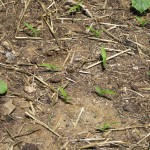
Baby Baby Corn I know what you’re thinking; you’re thinking, “Oh, no! Not more about peas again!” Well, yes, a little more about peas. It was time for them to go. I grew most of them from old seed just to use it up and to set nitrogen in the soil, since they are legumes. Some plants even had powdery mildew on them, which surprised me.
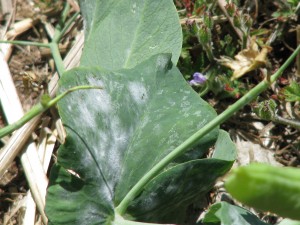
Powdery mildew I had to cut the plants off at the roots instead of doing it the easy way and pulling up the whole plants.
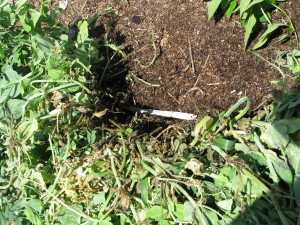
Cutting peas at their roots Since I’d hurt my right wrist a few weeks ago and I still haven’t allowed it to heal enough, the cutting wasn’t a fun job. It was worth it, though. I left the roots with their nitrogen-fixing nodules in the ground where they would do the most good.
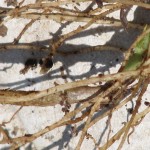
Peas set nitrogen in their roots Then I took all the pea vines up to the driveway, set up a chair, put on shorts and stuck my pale legs in the sun, plugged in an audiobook, and spent about an hour and a half tearing pea pods off of all the vines.
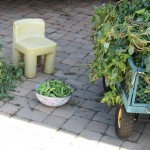
Harvesting time That night after dinner I began sorting through the pods and shelling them. I’m still not done.

Pea harvest I managed about half a big bowl of peas, which I sleepily shoved into the refrigerator before stumbling up to bed. My son was very calm in the morning when he told me about his surprise when he went for a midnight snack and spent about half an hour gathering up peas from the floor and adjacent rooms. I worked on more peas tonight. I’ve already frozen a couple of bags for our use; the rest will be frozen and used to feed the tortoises and chickens. All those pods and vines will combine with trash cans full of weeds I’ve been pulling along with kitchen trash to reconstruct my compost pile.
But there is life beyond peas. There are beans! I’ve planted several types of beans this year. Fresh green beans as well as soup beans and pinto beans. I’ve created two new raised beds and set them off from the rest of the garden. In them I’ve planted sugar baby watermelon, green melon, sugar baby pumpkin, and butternut squash.
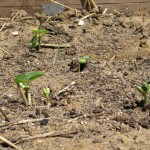
There's a pinto bean on the rise These vines will grow out rather than over other garden beds. In the middle of the beds I’ve planted pickling cucumbers, baby corn and pinto beans. They will all grow tall above the vines writhing and twining below. ( Hmm. Note to self: stay away from vine beds at night.)
Here’s an interesting piece of trivia: most gardeners have heard about ‘the three sisters’, which are the Native American pairing of corn, beans and squash. Actually, it should be four sisters, at least for Southwest Indians. The concept of the ‘sisters’ is that they form a complete plant ‘guild’. In other words, these three planted in combination produce more food than any one planted alone. The corn provides a trellis for the beans, the beans are a legume that fix nitrogen in the soil with nodules on their roots that feed off of sugars secreted by the corn roots (all this going on beneath your feet! Yikes!), and the squash forming a cooling, weed-suppressing ground cover that also deters raccoons (notorious corn-eaters who don’t like to walk through the vines). What is missing is a plant to attract and feed the pollinators. In the Southwest Anasazi settlements it was Rocky Mountain bee plant (Cleome serrulata), which has edible parts to it and fixes iron (the Anasazi used it as a dye plant as well as food). With an edible plant guild, we feed the soil and the pollinators as well as ourselves. You can read more about this in the fantastic book on permaculture by Toby Hemenway, Gaia’s Garden. An excerpt is right here: http://patternliteracy.com/the_three_sisters_or_is_it_fou I’m trying my fourth sister as dill weed, which is an excellent bee plant because of it’s small umbellate flowers. Dill also goes well as a flavoring for corn, cucumber and squash, and usually plants that complement each other taste-wise do well planted together, such as basil and tomatoes.
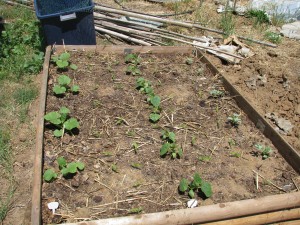
Cucumber, baby corn, watermelon and squash Speaking of which, my garlic/shallot/tomato and basil bed has taken off with the warmer weather. These are slicing tomatoes; I have planted Roma and a yellow variety in other beds.
Where the peas have come out, the broccoli, carrots, parsnips, lettuces, endive and cilantro are doing well. I’ve planted some small eggplant sprouts and more carrot seed so there is a continuous supply.
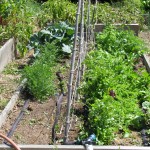
Life without pea plants Organic sweet corn will go into this bed, which will provide shade for the lettuces. Corn of different varieties must not come into silk simultaneously or they will cross-pollinate. The baby corn in the other bed will mature earlier by nature and by planting times. Those little corn ears can be eaten fresh or left to harden to be used for popcorn. The whole ear can be put into a microwave, for those of you who have such a newfangled contraption (I haven’t owned a microwave, um… ever!).
We’ve had new visitors to the garden. Besides my gopher snake friend (see my post Unsticking the Snake of May 14th), who has been seen again, and a longer gopher snake, my son and I saw a king snake whipping down a gopher hole in the lower Bee Garden, and then today this fellow came through the Chicken Tractor then through the Swiss chard and onion bed, and across the property.
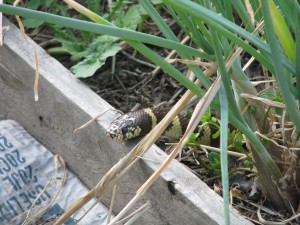
"So good to rest my weary head for a minute!" I’ve only seen one king snake in the yard who shows up in the height of summer to look for mice under the bird feeders. The standing water in the pond and the disturbance of the soil has attracted more of these friends, especially since my dogs are elderly and aren’t ‘making the rounds’ like they used to.
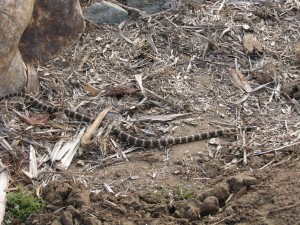
Banded kingsnake Kingsnakes are a little more tetchy than gopher snakes, and will eat other snakes including rattlesnakes. They can be striped or banded, even in the same clutch of eggs. Just like siblings with different hair colors.
Speaking of ponds, the standing water in the lower pond hasn’t receded very much, but has had an algae bloom.

Pea Soup Pond I’m going to have to have a well drilled on site, and have spoken with two well drillers and have received one bid, and am waiting for the third day for a call back. Honestly, is there so much work for some people in this economy that they can’t return phone calls or show up to appointments? During this gardening adventure of the last few months there have been several people of different occupations who just haven’t kept appointments or returned calls although they are still in business and initially shown interest. What’s up? Grrr.
The quinoa (pro: keen– wah) is doing well, and the potatoes are ready to harvest.
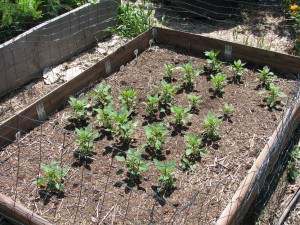
Quinoa rows Although I planted a whole packet of sunflower seeds throughout the property, only this blue jay-planted one in my strawberry bed came to anything. It looks like a puckered face!
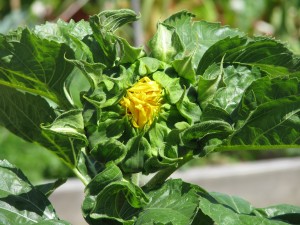
"Too much lemon!" -
A Scream in the Pond
I have a small lined pond in my front yard, created by my daughter and I a good five years ago or so. It is a pond gone native, for the most part, and I like it that way. The mysteries of what lives in those three feet of murky algae-laden water give me a shiver and excite my naturalist sense of curiosity (See post The Monster in the Pond of March 2nd). Sometime earlier this year as I was walking past the stretch of green that was partially covered with newly unfolding waterlily pads, I was startled from my reverie (I’m always in reverie it seems, especially now that I’m wrestling with mid-life crisis!) by what sounded like a small scream and a splash. I saw nothing. Hmm.
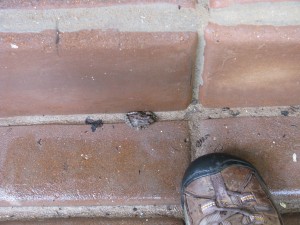
Young Pacific Chorus Frog During the most frigid, god-forsaken unpopular months of January and February, it seems as if every Pacific Chorus frog migrates from a forty-mile radius to mate in my small three-hundred gallon pond. Every night the males attempt to out-sing each other with such buzzes and chirps that even I’m impressed and tempted to follow their siren song, if only it weren’t so cold out there! (Wimpy San Diegan, I know!) Let their large ladies deal with them, I say. Sometimes their song is so loud that it becomes one giant noise. Often it drowns out whatever movie we might happen to be watching and we have to shine a flashlight out the window to startle them, catching them in flagranti as it were and quieting them for a short reprieve.

Pacific Chorus Frogs Taking a Break from Singing However, none of them scream. They sing.
When walking past the pond a few weeks later it happened again. A much louder scream and a splash. At least I knew that whatever it was hadn’t been so frightened by my passage that it committed suicide the first time. Then soon after my son came in from the front yard with a puzzled expression and said, “Something in the pond just screamed at me.”
There is a lot of algae in the pond which blooms about the time the frogs are mating, so I leave the frothy green bunches in place to protect the clear jelly sacks of spawn that cushion the frog eggs. Therefore, not much visibility at any time in my pond. Nope.
Finally I saw the screaming thing as it flung itself from the flagstones into the water. It was a large frog, much larger than the Pacific Chorus Frogs. Uh-oh.
When at breakfast I saw it sitting on the flagstone walkway around the pond through my bay window, my heart sank. It was a bullfrog. The glistening, beautiful green gigantic (for around here) frog sat there for awhile, then leaped into the undergrowth of my columbines.

Bullfrog about to go hunting through columbines American bullfrogs (Rana catesbeiana) are what you think of when and if you ever think of frogs. They can become huge. People farm them to eat their legs and back meat (oh ick!). Little American boys are supposed to spend their idle childhood summers wading through creeks (pro: criks) catching them and tickling their stomachs. I think they are a gorgeous and wonderful creature.
Except. Except that bullfrogs are not native to the Western states and they eat anything that they can shove into their mouths, including snakes, birds, rodents, other bullfrogs…. They are partially responsible, along with the red-eared slider turtles (America’s favorite pet turtle which was dumped wholesale into lakes and streams after the salmonella scare some twenty-five years ago and took over the waterways) and polluted water for endangering our native cute little Western pond turtles. So having this great screaming mouth eating down my mosquito fish, my Pacific Chorus frogs and their young, and everything else in the yard, is not good news in my book. Then my son noticed a second, smaller one. A male. Oh no!

Uh-oh. There's a male bullfrog, too! How to catch a bullfrog? I brought out an old cat litter bucket and a fish net and left them handy. We’d see the frog’s nose clearing the water, but by the time we’d go out there he would be long gone. Being very busy I didn’t have the opportunity to sit, net in hand, for hours waiting for my screaming frog to appear. (Hey, wait, shouldn’t that be ‘handsome prince’ instead of screaming frog? I get everything wrong!).
A few days ago on a sunny afternoon I was surveying the weeds in my garden, trying to burn them into cinders with my eyes without success. I walked along the pathway by the pond that was now almost completely overrun with peppermint, lazy stalks of columbine, the all-too vigorous Mexican primrose and the definately healthy weeds. I surveyed the back half of my garden making plans about weeding that had to be carefully done since many of the nasty little beggers were coming up in my heirloom bulb beds and their stalks looked almost identical.

Big Mama Wandering back I stepped through the overgrown columbine that hid the path when suddenly something big and shiny and screaming came flying up towards my knees from right under my foot. I also screamed and jumped. A second scream and leap to my left alerted me to the very large, very green bullfrog panting and staring at me with much the same expression that I must have been wearing as I stood staring and panting back. Even in my surprised state I realized that this might be my chance. Of course, the bucket was all the way over by the gate. I made a lunge for the frog but she evaded me. I managed to keep her from jumping into the pond and she disappeared under some weeds and mint by the bird bath. I squatted down and held down the grass hoping to contain her. I yelled for my son, but he was out of earshot. I started laughing, which I do so often in my life when I find myself in unusual circumstances. Come to think of it, I laugh pretty regularly. Maybe too regularly. Regaining control of the slight hysteria and my breathing, I slowly lifted up the grass… but she was gone. I knew she hadn’t jumped into the pond. She must have made her way along the sides of the flagstones. I made a plan. Quietly I stood and tip-toed around the back of the pond and around the end, making my way back toward the gate and the bucket with the fish net. Everything was still and I made no noise as I crept along. Just as I made it halfway past the pond, there were two almightly screams in close succession, two jumps and a splash. Fortunately it was the bullfrog who landed in the pond, not me. Shaking slightly with a trace of that hysterical laughter, I went inside to have a calming cuppa tea, and to give the lady frog time to settle her nerves as well. All that screaming had been a very girlie experience for both of us.
-
Water!

Upper pond and the Nest For the last two days we’ve experienced enough rain so that my permaculture adventures could be tested. Two storms, each bringing about half an inch of rain, created enough water for the watershed to begin to flow. Roger Boddaert and his team were busy rototilling urea into the areas which hadn’t yet been planted,

Freshly tilled areas soaked up water and Jacob from Aquascape and Jose were digging trenches for the drip irrigation system. They were very glad of the rain softening up the dirt!

Trenching for Irrigation Everyone was wet. Finally the rain gathered enough strength to flow down the street, under the fence from my wonderful neighbor’s property, and down the rain channel created by Jacob.

Water running in the trenches Some trenching had to be done to divert the water around the new Nest hut.

A diverting occupation Rapidly the upper rain catchment pond filled then overflowed down the rain channel into the second lower catchment pond.

Jose and I awaiting the overflow 
First Pond Filled 
Roger and Jacob ponding The scheme is that overflow from this pond will be channeled around the lower permanent pond and away so as not to overflow the big pond and erode the weakest and lowest end of the property around it.

Overflow water from the upper pond However since we were eager to see the big pond filled, Roger cut a trench from the second rain catchment pond to the big pond.

Overflow filling the second pond Earlier I had been in and out that morning on errands, and had settled in the house with a hot cup of tea and comfortable fuzzy pants on, when I realized that I was wasting water. I have three fifty-gallon rain barrels set around the house, which fill up within minutes and then overflow. Why wasn’t I channeling that water into the big pond? So of course I exchange my slippers for outdoor shoes (at least I did that!), put on a windbreaker with a hood, and go hauling hoses around to connect to the rainbarrels. I’ve had a sprained right wrist for a couple of weeks and pulling hoses was not the best medicine. So of course I did it, with my fuzzy pants wicking up rain and mud and beginning to drag under my feet. That’s me in a nutshell. Loving every minute of it. With three hoses leading down to the pond, all that wonderful roof runoff wouldn’t go to waste.

Connecting hoses to rainbarrels 
The Big Pond already collecting rainwater The big pond had had some water in it, enough for my son and I to put in a few mosquito fish to eat all the mosquito larvae. That water had been evaporating so there wasn’t much more than a large puddle at the bottom. By the time I put the hoses leading from the rain barrels into the pond, it had already been catching a significant amount of rainwater directly. Too bad I hadn’t thought of the hoses much earlier in the storm!
The rainstorm broke up too early for me, but more rain was on the way that night.
Waking up to the sound of rain is one of the nicest experiences for me, mostly because I live in a dry climate, I expect. The rain had set in well overnight, and I could see from my bedroom window a reflection from down below which turned out to be the lower pond!

Morning view from my bedroom! For a minute I thought it had filled up, but then I realized it was about a quarter full, and was impressed and excited about how it would look when completely full of water! The watershed rain was following the trench and going through the ponds, which were still holding water and allowing it to perculate into the soil.

Second pond in the morning The planted and mulched areas, and the areas newly tilled were soaking up water so well that there wasn’t any run-off from it. Of course, the rain was steady and we didn’t have any of those crazy intense rainstorms like we get in the winter, when it feels and sounds as if an enormous endless bucket has been overturned over Fallbrook. Those will be a true test of the system. Until then, I was very fortunate to have had this great rainfall to test the system right when the two major players were on hand. It was exciting.

The Lower Pond after the rains -
Honey Extraction by Crushing Comb

Honey Harvest Commercial bee hives, and most backyard beekeepers, use Langstroth (American standard) hives with frames lined with pre-pressed wax comb. This allows the bees to spend less time making wax and more time filling the hive with honey. To harvest this honey, keepers usually take out the honey-filled frames, run a de-capping knife down either side to cut off the white beeswax caps, run a knife or comb rake down across the cells to start the honeyflow, then place the oozing frames into the extractor. The extractor is closed, on some models it is heated, and then started. The frames whirl around the inside, using circumfugal force to get the honey off of the comb. The heated sides allows the honey to flow down through screens into a collection chamber. The frames with their cells can then be re-used into the hive for several years before the wax needs to be replaced. There are different scales of extractors, from a home-made one that holds two frames and is run with a drill motor, to large extractors that hold many frames and are heated so much that the honey runs like water. Extractors don’t work very well with frames that don’t start with pre-pressed comb, or Top-Bar Hive frames because the comb is too brittle to be reused.
There are a growing number of people who are not only pursuing organic beekeeping, but going to natural beekeeping. What is the difference? Organics don’t use pesticides to kill mites or treat the bees for various problems. To kill mites, they dust powdered sugar over the frames filled with mite-laden bees. The powdered sugar not only makes the mite’s sticky feet unable to stick, but also forces the bees to groom themselves more, which knocks the mites off and down through a bottom screen on the hive where they can be done away with. Natural beekeepers allow the bees to take care of themselves, using as little interference as possible. By observing what requirements the bees need to survive, by location of the hives and by not over-harvesting the honey, natural beekeepers are more in tune with their bees. For instance, the pre-pressed cells on wax foundation is larger than the larvae cells that bees would normally make. Varroa mites, a terrible scourge of bees, like the larger cells. If bees are allowed to festoon and make their own smaller-celled comb, there are fewer mites because the mites reproduce better with larger cells.
Naturally formed comb doesn’t work well in an extractor, so there are two things a beekeeper can do with it. One is to cut it up and sell it as pure honeycomb. The second is to crush it and allow the honey to drip through a mesh screen into a collection bucket. The latter is the process that we do, since we don’t have a lot of hives. Even with one hive, this process is a long one and physically demanding. As with all honey collection, it is best done on a warm day so that the honey will flow.

Honey-filled frames awaiting crushing The following photos are from a honey harvest last summer from our hives, and also from a wild swarm that I put into a hive just a couple of weeks ago (see my blog post Moving Bees on May 5th).
To crush comb, first we get our basic equipment. You need a long flat pan with sides, a potato masher, a spatula and a knife. You also need a clean food-grade bucket with a spigot on the bottom and a screen on the top and a lid. You can buy these, and believe me they are worth the price.

Empty bucket, screened top, and waiting comb If you don’t want to buy the bucket, you can always do what we did for our first honey extraction. You put clean buckets on the ground between two chairs, over which is suspended a sturdy and steady pole such as a broom. Once the comb is mashed, you put it either into layers of cheesecloth, or into cheap paint strainer bags sold anywhere paint is sold. Then you suspend it over the buckets and let it drip. If you squeeze it, the honey becomes darker. The cons of this are that dust will settle in the open buckets, and the chance of knocking the broom down is always a threat. Even on hot summer days, the dripping may take a week or more until almost all the honey is extracted. That is why covered screened buckets with bottom spigots are so worth the little extra money.

The Cheesecloth-Broom method! Cover the floor with newspapers, put some wet paper towels close by, put on some lively long-playing music and go to.

Cutting the comb from the frames First, remove a frame of comb and cut out the cells into the crushing pan. I stand the empty frames up on another pan which will catch the drips. Using the potato masher… start mashing.

Mashing the comb The goal is to crush the comb enough so that all the honey will drip out of it, taking pollen with it. Since you won’t be heating the honey artificially, and will only be screening once, most of the pollen and all the good vitamins, minerals and anti-bacterial goodness will flow right through and not be destroyed or screened out.

Cut comb laden with honey When that frame is thoroughly mashed, scrape it into the screen that is on top of your bucket… making certain that the spigot is tightly closed. Then start with the next one. This process will take some hours to do, even with two working on it.

Dark, brittle comb from a wild hive When the strainer becomes full then you can give it gentle stirs with a soft spatula, so you don’t tear the screening, or if you have another bucket put a lid on the full one and move on. Place full, lidded buckets in a warm area safe from ants where the sun can help with the warming and dripping process, without destroying the good stuff through heating.

Screen full of mashed comb When your bucket fills up with honey, then its time to decant. I use sterilized Mason jars with screw-on lids. Just open the spigot and be ready for honey to flow. Be ready to shut the spigot off quickly and wait for the inevitable drip.

Drawing Honey Honey should be kept in a dark cabinet, not in the refrigerator. It is naturally anti-bacterial, and has been used for centuries on wounds. It will not mold. It may crystallize, which is a reaction to the ambient temperature, since bees keep their hives between 91 and 97 degrees F. There is nothing wrong with crystallized honey; if you would like it liquid again, set the jar in a pan of hot water, or microwave it briefly. You even can get instruction on unclutterer on how to microwave specific foods like honey.
Once you are done extracting, you can set all the equipment and pile of discarded crushed honeycomb (unless you have other plans for it) out in an ant-free place near your hive for the bees to clean up.
The honey from our hive is very light in color and flavor, although it crystallizes within a couple of months (no problem there… it is also called creamed honey). The honey from the swarm that was in the nursery containers was almost caramel-like in color and consistancy, and had a darker flavor. Avocado honey is often dark, and there were many avocado trees in the area of the swarm.

Differences in Honey Crushing may be time-consuming, and not practical if you have a lot of hives, but for those of us with a hive or two it is worth the time and effort to not heat our honey and let it drip. Anything worthwhile is worth the time and effort it takes to do it. Just always, always, always be sure to allow the bees to keep at least one whole full super of honey for themselves, rather than robbing their honey and substituting it with sugar syrup. Hopefully you wouldn’t put soft drinks in your infant’s formula bottle, and neither should you give sugar -devoid of all the miraculous properties that honey has for the bee’s existance – as a substitute food for your bees. Bee a good bee parent.
-
Unsticking the Snake

A Stuck Snake This morning as I was wandering through my vegetable garden, I saw the middle part of a snake with his tail and head covered. This was late morning, and he wasn’t moving so I thought him dead. Fortunately he wasn’t. At first I thought he was a rattlesnake by the way his scales were rougher and the sound of a faint rattle when I moved the bamboo that lay under him.

All I could see of his body He wasn’t; he was a three and a half foot gopher snake, the same one I’d seen about a month ago for the first time in my yard. Just about all snakes shake their tails when giving a warning, but rattlesnakes have stacked hollow sections of keratin… the same material that is in your fingernails and hair… that bump together when shaken to create that rattle sound. No, there aren’t any balls inside. Rattles appear with age but can come off, so a very young rattler with only one button or a snake that has his broken off won’t make a rattle but will still shake his (or her) tail. But I digress.
This gopher snake was in distress because it had crawled through plastic netting that I had carelessly left on the ground. Once about 25 years ago I had a similar situation when I lived in Vista, when a gopher snake became emmeshed in the holes of a plastic garden netting I’d set up. It took me a while to free it, and it wasn’t nearly as badly stuck as this poor guy.
This netting was the type used to cover fruit trees to protect them from bird predation, and I had some that I’d used briefly over my pea shoots when the crows were eating them. I’d left the netting in a nursery can but over the months it ended up on the ground with a snake stuck in it. I had to carefully cut the poor thing out.
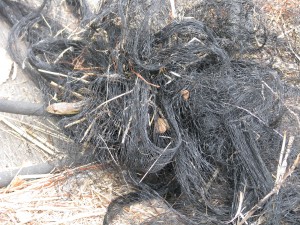
His head poking through About two inches of his head was showing once I pulled the netting back; not enough to swing around and bite me. He was stuck multiple times with the netting cutting into his skin in several places. I brought back a kitchen knife with a flat top and a sharp edge to it, so that I wouldn’t hurt him when I pressed down to slide the edge under the netting, but the tip of the knife wasn’t sharp enough. I ended up with some very sharp sewing scissors… the miniature kind shaped like a swan. And, of course, my camera.
The dilemma was that if I freed up enough of it’s middle it would try to push forward and become even more tightly stuck in the netting higher up. If I freed more of its top part first then it would have the leverage to turn and bite me.
When dealing with frightened animals (and people) you have to find the quiet part of yourself and work from there, without distraction and using a calm voice. Not only are your actions imperfect when you are tense or scared or angry, but that feeling emanates out from you and whatever you are working on will react to it. In other words, sensing your fear is a very real thing. I was very glad that this wasn’t a rattlesnake. The snake shook it’s tail at me several times and kept flicking it’s tongue out to smell me, but even though he wasn’t badly hurt or sick yet he was a very nice snake. I pulled the netting away from his head so that his trajectory when freed wouldn’t send him into more of the plastic loops.

"Help me!" Then I started sliding the scissors as gently as I could under the plastic netting that was pressed into his soft skin and cutting him free. He was badly stuck so it took some time.
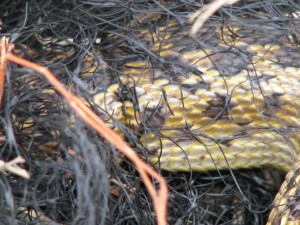
Plastic pressed into his delicate skin All the while I spoke calmly to him, and knew that he would only feel relief after each of my actions so he’d know I wasn’t doing him harm. Finally I got to the netting around his… um… neck? He turned his little head but wasn’t rattling or coiling in preparation to move suddenly.

The last bit of netting With the last snip he raced away several feet to the shade under a nearby lime tree.
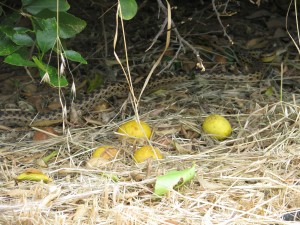
"Thank-you, Diane!" There he sat looking back at me. I waved and told him he was welcome to all the gophers he could eat, and threw away the netting.
The lesson here, of course, is to be careful with the debris you leave around your yard. Could it be an animal trap? Think beyond it to the animals at the dump where your trash ends up. Snipping your 6-pack plastic rings might save the lives of seagulls, water creatures (if it ends up somehow in the water), or rodents. Of course, going plastic-less would be the ideal but still wouldn’t eliminate injury to animals. Tin cans are stuck on animals’ heads all the time. Just be aware of what you have lying around and consider if it could be a hazard or not. That way it might save you from snipping plastic rings off a snake someday.
-
The Nest
Creative thinking, recycling, scrounging for materials, looking through books for ideas… it can add up to wondrous creations. After seeing a hut built like a nest in a book, Roger Boddaert who is installing my permascape garden pulled together a lot of scraps and came up with my own nest. He and his team worked magic.
Beginnings Three palm trees that had been, well, decapitated, then stripped of their calyxes, became the main pillars for the structure.
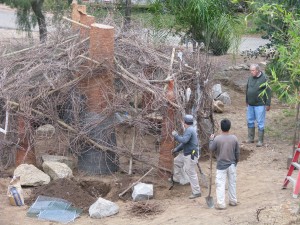
Creative Direction Old wire that was left over from old gardening trellises and even from the previous owner was wrapped around more palm trunks moved over for the framing.
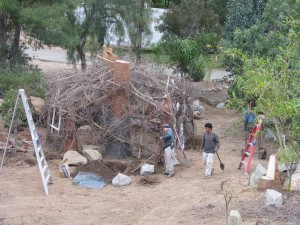
Bundling Grape Vines Wood from the sheds that had been destroyed was used for a window and doorways. Then grape vine cuttings that Roger’s neighbor had left over from his vineyard were bundled up and tied onto the wire frame with wire.
Old shed wood for frames Wisteria and jasmine, among other plants, will eventually grow all over this trellis.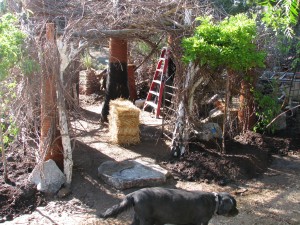
Straw will be strewn on the ground More vining plants are planted inside.

Abutilon planted inside An old gate left over from the original owners… who probably reused it from something else.

Old Gate To do the roof, Juan made due with what he had.
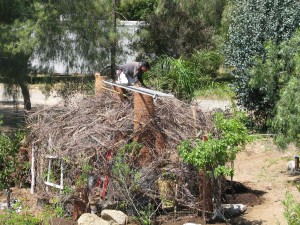
Roof access Then stretched just a little more!
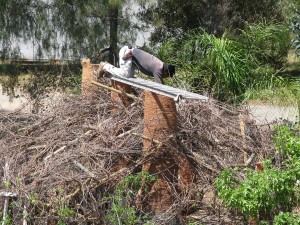
Precarious Perch With a wall made of broken cement to define the walkway and planted areas, it is finished.
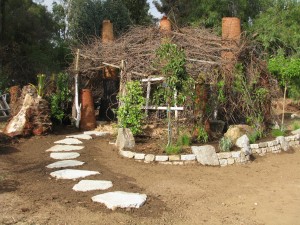
Finished! Inside a palm tree forms a bench.

The Inside All the times I mowed around these palm trees can be forgotten as they are now exotic support beams.
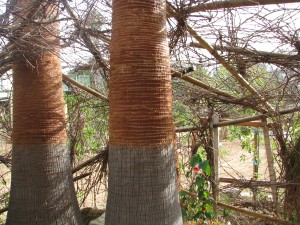
Rooted palm pillars A little bit on the crazy, fairy-story side, this structure will only mature as the vines take over. What a great addition to the garden!

Magic Hut -
How to Blanch

Ice Bath When preparing fresh vegetables for the freezer, the best way to do it is to blanch them. Canning vegetables is another method of storage that doesn’t rely on electricity to keep fresh, but I’m not going into canning here. For the freezer storage method, clean the vegetables (which is the most time-consuming part of the whole process. Turn on an audiobook or watch the birds out the window while you work!), then briefly submerge portions in boiling water for a couple of minutes. Immediately plunge them into an ice bath.

All You Need to Blanch 
Blanching Swiss Chard 
If You Have a Lot, Use a Larger Pot! The quick cooking softens them and sets their color, and the ice stops the cooking process.

Swiss Chard in Ice Bath 
Chard in boiling water, ice water, and awaiting blanching Then you dry the vegetables and freeze them. To dry them off, you can spread them in clean dish towels and squeeze or blot them dry, or you can drag out that old salad spinner that has lived in the cupboard for twenty years and put it to good use. If the veggies are pieces, then for ease of use you separate them on a cookie sheet and freeze for about half an hour or less, then pour them into freezer containers. For clumps, such as with Swiss chard, spinach, kale or other leafy greens, spread them out as thinly as you can on a cookie sheet and freeze, then break up and put into freezer containers. When you go to use them they won’t be frozen into one big blob, and you can use what you want to and reseal. Be sure to mark the container with the date.

Frozen Bagged Sugar Peas I’ve just had an enormous snow pea harvest, as well as three plastic grocery bags stuffed full of Swiss chard. To save water, I cleaned all the chard and a plastic grocery bag half full of snow peas, then blanched the peas first and then the chard. Besides washing the peas and chard (look back a few posts about how to cook Swiss chard), the peas had their stems pinched off and any tough vein stripped from the sides. The chard was de-stemmed and torn up. All this preparation might seem to be too much work. However, I have frozen freshly grown organic vegetables whenever I want them, and there is nothing… I repeat nothing… so good as to eat produce you raised yourself and to feed all that love and care and work and sunshine to your family.
When finished you’ll have a lot of dark water. Don’t throw it out! It is heavy with vitamins from the produce. Some hard-core enthusiasts would add it to soups or smoothies, or drink it. I cool it and water my plants with it. I try to be healthy, but some things are just going too far!
